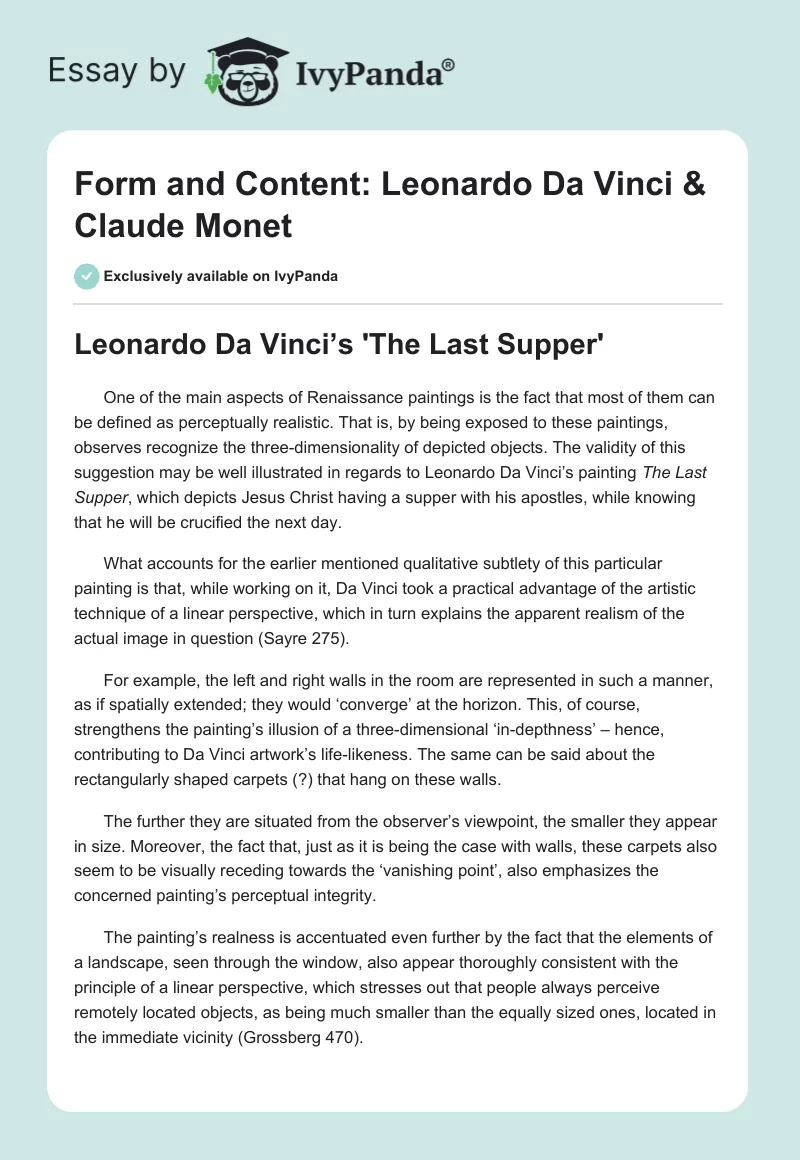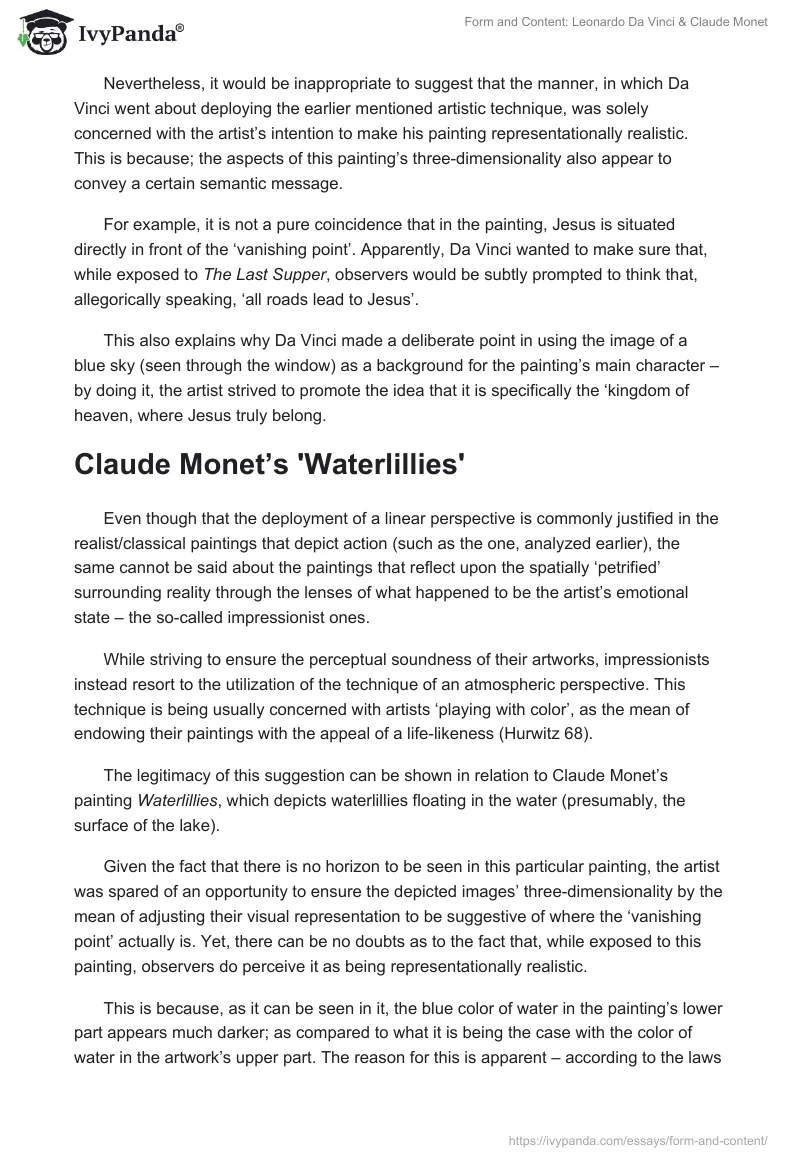Leonardo Da Vinci’s ‘The Last Supper’
One of the main aspects of Renaissance paintings is the fact that most of them can be defined as perceptually realistic. That is, by being exposed to these paintings, observes recognize the three-dimensionality of depicted objects. The validity of this suggestion may be well illustrated in regards to Leonardo Da Vinci’s painting The Last Supper, which depicts Jesus Christ having a supper with his apostles, while knowing that he will be crucified the next day.
What accounts for the earlier mentioned qualitative subtlety of this particular painting is that, while working on it, Da Vinci took a practical advantage of the artistic technique of a linear perspective, which in turn explains the apparent realism of the actual image in question (Sayre 275).
For example, the left and right walls in the room are represented in such a manner, as if spatially extended; they would ‘converge’ at the horizon. This, of course, strengthens the painting’s illusion of a three-dimensional ‘in-depthness’ – hence, contributing to Da Vinci artwork’s life-likeness. The same can be said about the rectangularly shaped carpets (?) that hang on these walls.
The further they are situated from the observer’s viewpoint, the smaller they appear in size. Moreover, the fact that, just as it is being the case with walls, these carpets also seem to be visually receding towards the ‘vanishing point’, also emphasizes the concerned painting’s perceptual integrity.
The painting’s realness is accentuated even further by the fact that the elements of a landscape, seen through the window, also appear thoroughly consistent with the principle of a linear perspective, which stresses out that people always perceive remotely located objects, as being much smaller than the equally sized ones, located in the immediate vicinity (Grossberg 470).
Nevertheless, it would be inappropriate to suggest that the manner, in which Da Vinci went about deploying the earlier mentioned artistic technique, was solely concerned with the artist’s intention to make his painting representationally realistic. This is because; the aspects of this painting’s three-dimensionality also appear to convey a certain semantic message.
For example, it is not a pure coincidence that in the painting, Jesus is situated directly in front of the ‘vanishing point’. Apparently, Da Vinci wanted to make sure that, while exposed to The Last Supper, observers would be subtly prompted to think that, allegorically speaking, ‘all roads lead to Jesus’.
This also explains why Da Vinci made a deliberate point in using the image of a blue sky (seen through the window) as a background for the painting’s main character – by doing it, the artist strived to promote the idea that it is specifically the ‘kingdom of heaven, where Jesus truly belong.
Claude Monet’s ‘Waterlillies’
Even though that the deployment of a linear perspective is commonly justified in the realist/classical paintings that depict action (such as the one, analyzed earlier), the same cannot be said about the paintings that reflect upon the spatially ‘petrified’ surrounding reality through the lenses of what happened to be the artist’s emotional state – the so-called impressionist ones.
While striving to ensure the perceptual soundness of their artworks, impressionists instead resort to the utilization of the technique of an atmospheric perspective. This technique is being usually concerned with artists ‘playing with color’, as the mean of endowing their paintings with the appeal of a life-likeness (Hurwitz 68).
The legitimacy of this suggestion can be shown in relation to Claude Monet’s painting Waterlillies, which depicts waterlillies floating in the water (presumably, the surface of the lake).
Given the fact that there is no horizon to be seen in this particular painting, the artist was spared of an opportunity to ensure the depicted images’ three-dimensionality by the mean of adjusting their visual representation to be suggestive of where the ‘vanishing point’ actually is. Yet, there can be no doubts as to the fact that, while exposed to this painting, observers do perceive it as being representationally realistic.
This is because, as it can be seen in it, the blue color of water in the painting’s lower part appears much darker; as compared to what it is being the case with the color of water in the artwork’s upper part. The reason for this is apparent – according to the laws of physics, the sharper is the angle between the observer’s viewpoint and a particular sun-reflecting surface, the ‘lighter’ this surface would appear to the person in question.
Therefore, while standing in front of Waterlillies and observing it, people intuitively sense that this painting is perceptually adequate. After all, it would prove impossible to find even a single person who had not stood on the shore of a river/lake at least once in his or her life.
Hence, the impressionist realism of Monet’s Waterlillies – people can well relate what is depicted in this painting to their subliminal memories of the past. This, of course, suggests that, even though that the technique of an atmospheric perspective does not quite correlate with the one discussed earlier, it nevertheless is just as capable of ensuring the concerned paintings’ perceptual three-dimensionality.
Works Cited
Grossberg, Stephen. “The Art of Seeing and Painting.” Spatial Vision 21.3-5 (2008): 463-486. Print.
Hurwitz, Laurie. “The Well-Planned Spontaneity of Claude Monet.” American Artist 60.644 (1996): 56-64. Print.
Sayre, Henry. World of Art (6th edition). Upper Saddle River: Prentice Hall, 2009. Print.


